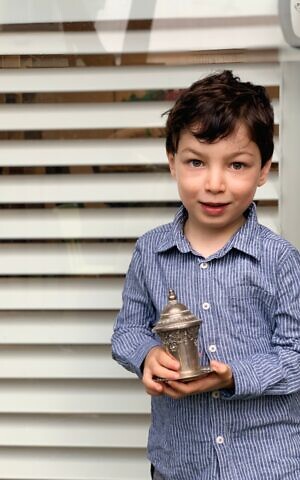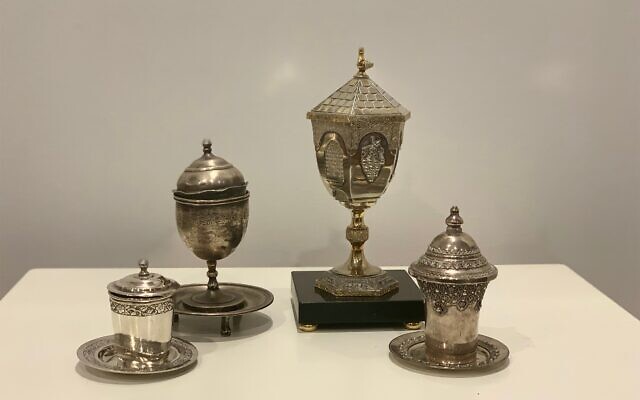A different Rosh Hashanah
Growing up Sephardi meant editor Jessica Abelsohn did things very differently to her Ashkenazi friends. Her Rosh Hashanah table, especially, is a world away from dipping apple into honey. She shares her experience on how it felt growing up Sephardi in an Ashkenazi world and explains how her Rosh Hashanah table is set.
When I was younger, I knew I was different. The way my grandfather said kiddush was different, my synagogue was different, our Sefer Torahs were different, even the way we said hamotzi was different.
But I revelled in the uniqueness of being brought up as a Sephardi Jew. I still do. And I’m very proud to come from the Benjamin family, with our roots in Baghdad and Bombay.
Rather than having gefilte fish and roast chicken for Shabbat dinner, I enjoyed curries, kubbeh (meat-stuffed rice flour and semolina balls) and hameem (an Iraqi chicken and rice dish made with cardamom, clove, cinnamon and turmeric). I baulked at the very idea of a whole meal to break my Yom Kippur fast, rather enjoying bite-sized favourites of cheese samosas, date barbas (homemade pastry with date filling) and agar agar.
Going to a modern Orthodox Jewish day school, I was taught Ashkenazi Judaism of apples and honey for Rosh Hashanah, and no rice on Pesach. Prayers were sung differently, which was something I grappled with, being so used to the melodic voices of my great-uncles singing in their Sephardi drawl – think of Arabic meeting Hebrew and you’ll get the idea.
But my Sephardi Judaism was nourished at home.

When I got married (to an Ashkenazi, who has lovingly adopted a lot of my Sephardi traditions), while we received beautiful Ashkenazi kiddish cups, I yearned for a traditional Baghdadi one with a lid and a saucer, just like my great-grandmother had brought over from India.
The lid to protect and honour the wine and the saucer to catch any that spilled from the overflowing cup – because according to my grandmother, you never waste wine that has been blessed. My father eventually managed to track one down and now it stands, pride of place, in my Judaica cupboard.
My sons are following in my modern Orthodox Jewish day school footsteps, and over the past couple of years, my eldest, now almost five years old, has noticed he’s a bit different too. He proudly took our Iraqi kiddish cup for his kindy Kabbalat Shabbat and he asked a million questions about why Pesach was different with mummy’s family – where we sung in Hebrew and Arabic, where we poured the plagues and threw them outside rather than dipping our pinkies, and where our seder plates featured halek (date syrup with crushed walnuts) rather than charoset.
And just like our Pesach table, our Rosh Hashanah table is very different too.
While our Ashkenazi friends say the prayers, dip their apples in honey and then devour their meals, we have several brachot we say before we even get to the soup.
Fresh apples and honey don’t feature for us Sephardis.
So, what does a Sephardi Rosh Hashanah table look like?
The Sephardi prayers
For the Benjamin family, we follow the Iraqi traditions. Families who have roots in countries such as Morocco, Spain, Ethiopia and other North African and Middle East nations may follow slightly different versions.
For many years, my great uncle would say the prayer over a single plate of food before it was passed around the long Rosh Hashanah table for everyone to take a serve, much like we pass the hamotzi around. It would take hours!
Now, in the interest of time, we set another entrée plate for each person with the individual items of food and as a family, we recite the blessings together, as omens for a healthy, happy and sweet new year ahead.
Once we’ve blessed the wine, washed our hands and said hamotzi, we get started on our plates.
- We make a blessing for fruits grown on trees over a date with a coconut filling and fruits grown in the ground with cucumber.
- We ask that our enemies and those who seek us harm to be consumed with a prayer over a date.
- We ask for goodwill and increased merits by blessing a bean.
- We decimate our enemies and those who seek us harm with chives.
- We remove our enemies by blessing and eating spinach.
- For years, we used marrow to ask that our bad decrees and judgements be torn up. Then we decided to use something much more delicious such as zucchini or pumpkin.
- We ask that our mitzvot be plentiful like the seeds of the pomegranate.
- Then, instead of the apple and honey, we ask to be renewed for a good and sweet year with cardamom-spiced apple jam.
- And for our final blessing, to be at the head and not the tail, and to remember the sacrifice of Isaac by Abraham, we make a blessing over tongue.
When that’s done, we tuck into a delicious meal of curry, special sultana and almond- covered rice, and meat roast. But don’t worry, we still finish it off with honey cake.
The 2021 difference
Our Rosh Hashanah tables may look even more different in 2021, without our extended families surrounding us, as the country deals with the latest COVID-19 Delta outbreak.
In previous years, I have been fortunate to have four generations of my family under the same roof to bring in the New Year.
This year, while we may be decimating and removing our enemies over Zoom, the love and warmth of our Iraqi Rosh Hashanah will still shine through, as we teach the next generation what it means to be uniquely Sephardi.


comments